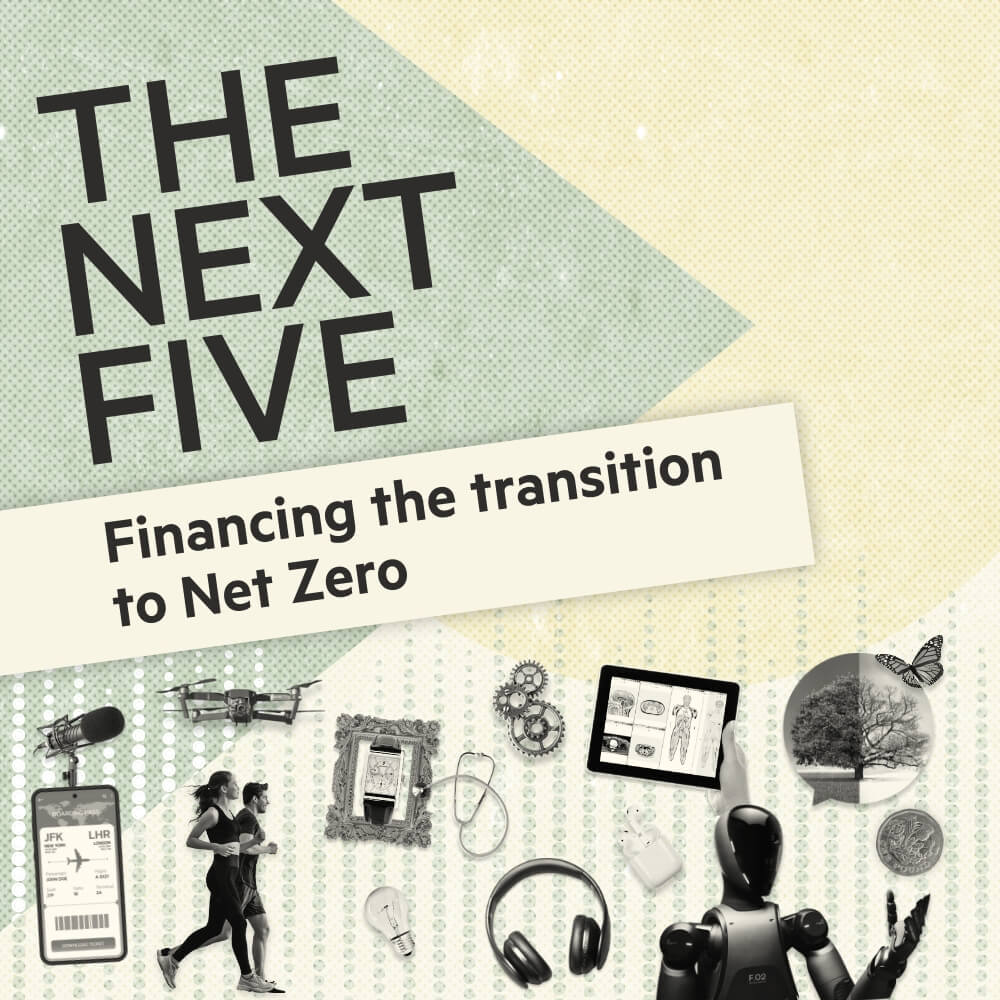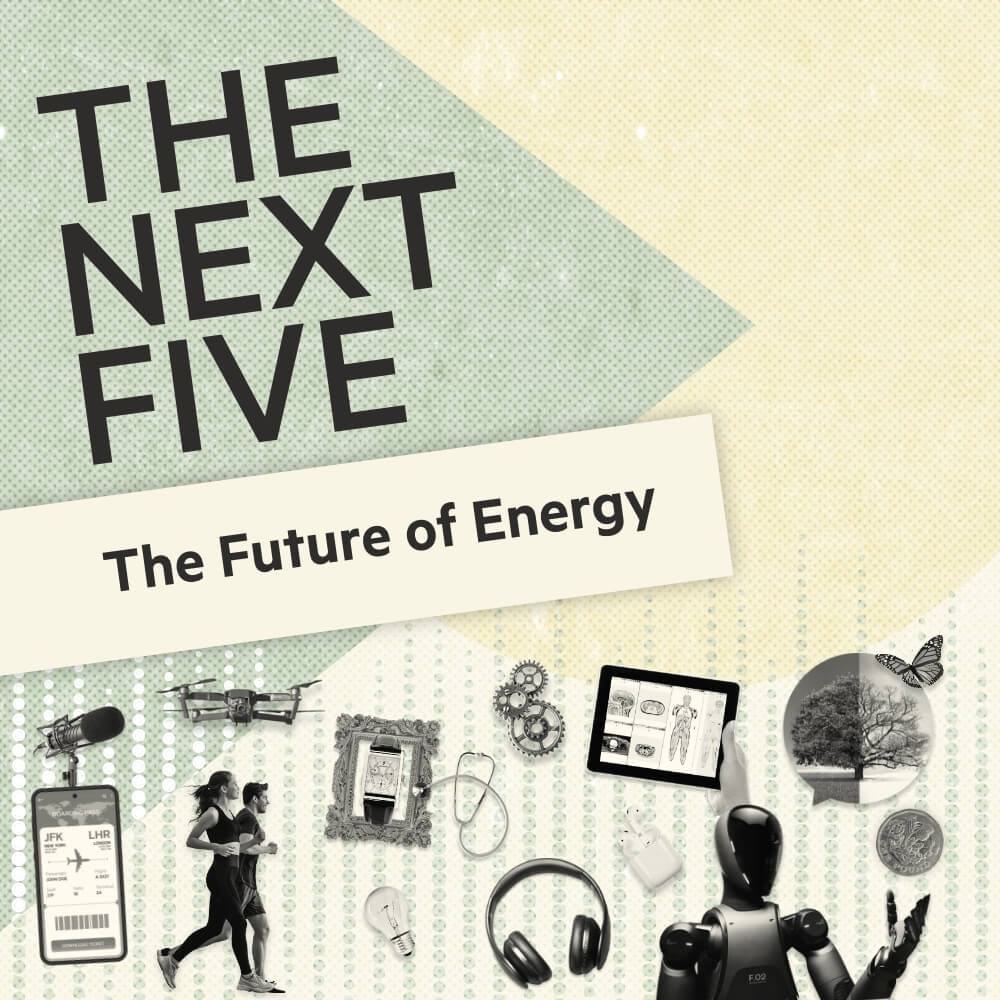THE NEXT FIVE
THE NEXT FIVE - EPISODE 26
Our Energy Future: Balancing climate goals with reliable supply
It's all about policy: the next five years of renewable energy and security






































The Next Five is the FT’s partner-supported podcast, exploring the future of industries through expert insights and thought-provoking discussions with host, Tom Parker. Each episode brings together leading voices to analyse the trends, innovations, challenges and opportunities shaping the next five years in business, geo politics, technology, health and lifestyle.
















Featured in this episode:
Tom Parker
Executive Producer & Presenter
Torgrim Reitan
CFO and EVP at Equinor
Rebecca Williams
Deputy CEO of the Global Wind Energy Council (GWEC)
Irina Kustova
Research Fellow at the Centre for European Policy studies (CEPS)
The world is grappling with the need to hit the global Net Zero by 2050 target which means the net amount of greenhouse gases emitted into, and removed from, the atmosphere is zero by that date. All the while providing safe, secure and affordable energy for citizens.
A tug of war between outcomes is afoot, where difficult decisions and trade-offs will need to be made by governments, energy majors and consumers. Energy security is key for economic resilience. Progress made in the last few decades in the UK and Euro area was buffeted by the Russia Ukraine war. Geopolitical events, such as mounting international tensions in the Middle East, could create further energy shocks. However, according to the European Security Mechanism, to enhance resilience to energy supply shocks, the EU needs to increase the use of domestically produced renewable energy. In this episode of The Next Five Torgrim Reitan, CFO and EVP at Equinor discusses the need for a balance between transitioning to renewables and offering stable supply of reliable energy sources such as natural gas. Rebecca Williams, Deputy CEO of the Global Wind Energy Council (GWEC) offers insight into the future for wind projects and how renewable energy can provide much needed energy security. Irina Kustova, Research Fellow at the Centre for European Policy studies (CEPS), highlights the policy landscape surrounding the energy ecosystem and the challenges and opportunities ahead.
Sources: FT resources, National Grid, European Commission, WEF, windeurope.org, European Security Mechanism, Mckinsey, S&P Global Commodities Insights, IEA.
READ TRANSCRIPT
- Tech
Transcript
Our Energy Future: Balancing climate goals with reliable supply
Our Energy Future: Balancing climate goals with reliable supply
Soundbites:
TOM: Hitting climate goals in the current economic climate is proving difficult
TORGRIM 08:00 clearly, there's a lot to be done across industries and regulators to successfully deliver on emissions.
TOM: Especially while energy security and stability are in the limelight
IRINA 02:39 we have a much more volatile global context and macroeconomic conditions
TOM: there are challenges now and on the road ahead
IRINA 23:13 The key pain point for the outgoing political cycle will be investment uncertainty.
TOM PARKER:
I'm Tom Parker, and welcome to the next five podcast brought to you by the FT partner studio. In this series, we ask industry experts about how their world will change in the next five years, and the impact it will have on our day to day. In this episode we discuss the balance between hitting net zero by decarbonising our economies and providing secure energy throughout the transition as well as the investments in renewable alternatives.
TP:
The world is grappling with the need to hit the global Net Zero by 2050 target which means the net amount of greenhouse gases emitted into, and removed from, the atmosphere is zero by that date. All the while providing safe, secure and affordable energy for citizens.A tug of war between outcomes is afoot, where difficult decisions and trade-offs will need to be made by governments, energy majors and consumers. Energy security is key for economic resilience. Progress made in the last few decades in the UK and Euro area was buffeted by the Russia Ukraine war. Geopolitical events, such as mounting international tensions in the Middle East, could create further energy shocks.
Irina (00:58.286)
2022 was a shock, a profound shock.
TP:: This is Irina Kustova, research fellow at the Energy Resources and Climate Change Unit at CEPS, the Center for European Policy Studies.
And all the events required a profound restructuring of energy flows, including energy imports, fossil fuels imports. And that came and is still coming with an impressive cost, a high cost for the European Union.
Irina (02:38.126)
And maybe what is new to energy security, of course, we operate now in a quite different context.
So we have a much more volatile global context and macroeconomic conditions are not that impressive and you can hear, like you can read all the details in the Draghi report, so everything is clear there and we have inflation, have raised capital costs, it all does not create a positive context to operate in.
Irina
So in terms of security of supply, the price level of natural gas will be significant...
issue to be discussed and addressed in the next political cycle because natural gas will still play an important role in electricity markets because natural gas is a marginal price sector in the current electricity market design. So any natural gas price spikes will inevitably spill over to electricity markets and even if the demand for natural gas has rapidly decreased over the last two years it will continue to decline. In line with decarbonisation targets, even if the demand for natural gas is decreasing, still natural gas well is moving from volumes to values, which is how I put it in my recent paper published this October. So we still, even if we have less volumes, we still have very significant impacts of natural gas prices on electricity markets and as a result of energy transition. So for policymakers, it would be also important to continue this discussion on how exactly we are going to secure affordable levels of natural gas prices while moving to keeping on track with energy transition.
TP: According to the IEA, we are not yet at our peak of global fossil fuel use, projections of which set 2030 as the height. For all our best intentions to switch to renewables as quickly as possible, the truth is we will require fossil fuels to be a part of our energy mix. However, according to the European Security Mechanism, to enhance resilience to energy supply shocks, the EU needs to increase the use of domestically produced renewable energy. But how can this be achieved in the near term, given that it's easier to rely on incumbent fossil fuels for security and stability?
Torgrim Reitan (03:50.144)
it takes time to change an energy system and it takes a lot of investments and it takes a lot of coordination across various players as such.
TP: This is Torgrim Reitan, CFO and EVP at Equinor, a broad energy company engaging globally in oil and gas, renewable and low carbon solutions.
And we need to scale up in all elements of these value chains for this to be successful. We will do our part. And then currently we are investing heavily into, you know, the docker bank.
Offshore wind projects, now, outside the UK, east to east of the UK. That will be sufficient to supply 5 % of power to the UK. So that is a massive undertaking. In addition, we are building large offshore wind farms in Poland. And then we are engaged in solar and some onshore wind activity as well. So clearly we invest significantly into those projects. What is becoming clearer and clearer is that the market will need flexible power in addition to sort of backup renewable power. Clearly one technology which is there is of course batteries. We are investing in that, but we do think that will become much more important and larger. And then clearly we will be looking for opportunities to also scale that. But you know, no matter how large the battery will become, we need more flexibility. And then here is where sort of natural gas is playing a fundamental role and builds to a larger degree, I would say, in the future, because it is flexible, you can store it, you can have gas-fired power plants, ultimately, we carbon capture to manage this flexibility. And that is sort of the soft point around energy policy for the time being. It's sort of what is the backup for renewables and how are the markets going to be regulated to facilitate renewables and sort of the things that need to support it. So clearly, we are leaning very much forward.
Torgrim Reitan (06:14.23)
We are investing into projects. But clearly, there's a lot to be done across industries and regulators to successfully deliver on emissions.
TP: While stable and secure supply of energy rely on incumbent oil and gas led systems, renewables can provide energy security needs.
Irina (09:51.0)
Of course, the expectation in the EU is to double down on decarbonisation, and that's very clear also in the post 2022 context. So speeding up renewables uptake is of paramount importance, and the Repower EU plan is all about this. We need to deploy renewables at a faster speed, and it's also about more ambitious renewable energy targets that were negotiated last year. So energy security and renewables are really going together. And the expectation is that our energy system will be electrified as much as possible. So the first principle is to electrify whatever we can, whatever is possible and then the rest will be filled with molecules and these molecules should be low carbon or green. So by molecules I refer to renewable gases, by methane and green hydrogen and other renewable gases. But here the concern is that we need to double down on electrification, which is currently below a quarter of the final energy consumption in Europe.
And of course the biggest share of renewables is in power generation and the power sector is doing very well in terms of decarbonization and is well on track.
Irina (12:05.62)
Industry will also need a lot of renewables in terms of low carbon renewable electricity and this electricity in most cases will need to be dispatchable, so available at any moment and that also gives a lot of food for thought and a lot of work for policy makers in the next cycle because for decarbonizing industry, for decarbonizing, for ensuring energy transition we will need a lot of low carbon dispatchable energy.
09:55
TP: Investments in renewables are increasing to try and keep pace with net zero goals. According to the S&P Global Commodities Insights report, clean energy technology investment will reach $800 billion in 2024, a rise of 10-20% in 2023. By 2030 investments are expected to rise to $1 trillion. 55% of the investment is going into solar, second is onshore wind. Energy storage and electrolysis are the fastest growing segments; in 2024 alone 150 green hydrogen projects and 65 CCUS that include transportation and storage will be commissioned.
But for the oil and gas majors their portfolios still mostly contain fossil fuels. In order to invest in projects, such as offshore wind and CCS where their decades long experience is best placed, their balance sheets must remain competitive for shareholders. According to Mckinsey, CCS needs to increase by 120 times to offset 45% of emissions in a 2050 Net Zero scenario therefore O&G companies must remain financially able to do so. Cutting too quickly and the market would punish them, but shrinking it over time will allow for investment into projects where they can gain a competitive advantage in line with demand and government policy.
Torgrim Reitan (09:18.602)
This is sort of a balancing act. We are a true believer that oil and gas will have to play a significant role for many, many decades. And we will continue to invest in that. So in Norway, we now see that towards 2035, we can deliver on the same level as we as we currently are producing and internationally is also very flat. So we will continue to invest actually around 10 billion dollars a year into oil and gas. What is extremely important is to make that with as low a CO2 footprint as possible. So currently we have emission per barrel around below 7 kilo per barrel. The global average is 16 to 17 and we'll continue to.
reduce that. We are currently investing significantly into electrification of platforms in the North Sea as such. But on top of this, we are building a renewable business and a low carbon business that is going to be significant because we do believe in the longer term that there will be a lower demand for oil and gas and we see gas being longer lived than oil. But ultimately,
we need to replace that with something else. And that is what we do. We are a long-term investor in sort of the new business here. So that's a fine balance. For us, it is extremely important that it creates value. And there is sufficient return. And focusing on value instead of volume when we deliver on this strategy.
So within renewables and low carbon solutions, we have created significant value so far.We have had double digit returns on everything that we have done. But of course, we see that there is a lot of money chasing two opportunities and that returns are sort of challenged as such. So clearly, we need to be disciplined as industries to see that we actually are creating value as we grow these businesses.
Torgrim Reitan (20:13.068)
So we have clearly said, you know, we are going to be compatible with the Paris agreements as such. And we have set very ambitious targets when it comes to being net zero by 2050. And we are sort of setting a target on net carbon intensity leading to that number and also addressing scope one and scope two.
emissions. So all of those targets sort of are firm and sit firm. However, we need to be probably a little bit more flexible in the way we deliver on this strategy. And maybe a recent example is that the acquisition of 10 % shareholding in Ørsted, which is an integrated
part of the way we want to deliver on this. And we have seen that doing that is cheaper than building by yourself for the time being. Meaning, building a green field for the time being is expensive and competing for seabed leases at the current prices is too high. And you won't see us paying $2 billion for a seabed lease. We'd rather see us buying a share in something that works well at a lower cost. So that is about sort of adjusting to how we deliver. Targets remain firm, but getting time right and being disciplined is very, very key to us.
TP: Regardless of the desire for energy companies to move towards renewables, they face criticism about the rate of progress while still providing fossil fuels to economies?
I'm living fine with the criticism. That is what democracies and societies are built around. So we really appreciate that people have opinions about how we go about our business.
Torgrim Reitan what is very important for us is that we do deliver and produce the energy needed today for, you know, society while we are building the energy systems for the future.
And we are saying that we are going to move in line with society and actually lead the way as we move. But of course, we need to be very diligent. That sort of if the pace of change in society is being adjusted to change, we also need to adjust because we can sort of be an outlier in this.
So we will continue to invest in oil and gas.
And then we're going to build renewables and a low carbon solution business on top of that. And it is going to be a significant business over time. So that's all of the balancing that we do.
TP: Other major challenges exist when it comes to balancing net zero ambitions and the current energy mix. Inflation has not only created a cost of living crisis that means consumers opt for cheaper over greener, but higher interest rates also reduce renewables’ competitiveness in energy markets. According to WEF,a 2% rise in the risk-free interest rate increases the levelised cost of electricity for renewable projects by 20%, compared with only 11% for a combined cycle gas plant.
Rebecca Williams (08:03.365)
When we're looking at the EU as this kind of supranational body, as well as a collection of 27 member states, I think that it's important to recognize that there are things that can be achieved at that EU level. And then there's also the efforts by the countries themselves in order to meet targets and to realize that So I think when we look at what the EU can do, there has been a great effort to kind of standardise and to speed up things like permitting. And I think we are hopefully starting to see a new wave of projects which can be unlocked by that
Rebecca Williams (09:04.995)
faster permitting regime and that's been a key blocker for a lot of projects within the EU because ultimately this is all a game of risk right? When you're developing a wind project it's about your ability to manage and handle different risks
But I think that when we're then talking about permitting, we're talking really about planning permission and the longer that you're leaving your project exposed to those exposed in the planning process and not being able to kind of move forward and ultimately help investors see and realize their investment, the more that's going to have a knock on impact on the cost of capital that a project can achieve. 18:21 And for every 1 % increase in cost of capital of an offshore wind project, that's an 8 % project cost increase. So it has a huge impact on risk and then cost. So that's why permitting is really important. It's why we here in the industry bang on about it all the time. It's not just because we dislike bureaucracy. It's actually because it's having a material impact on the affordability and cost base of our projects. So any countries that can speed up permitting regimes, that's very welcome.
TP: According to the IEA’s October 2024 report, the global capacity of renewables is expected to increase 2.7 times by 2030, surpassing countries’ current ambitions by nearly 25%. However this just falls short of the tripling target set at COP 28 last year. The growth has been helped by energy security and climate policies in nearly 140 countries that have made renewables cost-competitive with fossil-fired power plants. Recent financial difficulties in the wind sector are expected to ease following policy changes in auctioning, permitting and grid connection, with the IEA forecasting the doubling of wind power capacity between 2024 and 2030 compared to the previous six years. However, continued policy support is required and within Europe other challenges need to be overcome to allow for the transition to renewables.
Irina (13:21.91)
On the side of manufacturing, so clean tech equipment, yeah, that has been a big debate in the last two years. And I think everyone heard about the discussions on the Net Zero Industry Act. And the big question is whether we have enough domestic manufacturing, whether we have enough facilities and have capacities to manufacture all clean tech we need and by this I mean from solar PVs to wind turbines and electrolyses for green hydrogen production and so on. And the second question, are we competitive globally in these industries? And that's a very highly pressing political question.
How do we actually ensure that we have enough domestic manufacturing capacities?
And also a big question will be about critical raw materials, both in terms of access to them. And here we can see all geopolitical games and tensions and new emerging dependencies and vulnerabilities. And also a big question will be on circularity and how recycling of critical raw materials inside the European Union can help actually reduce all these dependencies.
We need people, green jobs, skills and services that we will need to actually ensure that we are able to produce and manufacture this clean tech equipment we need to uptake renewables.
TP: The speed of uptake of renewables is in part due to efficacy and efficiency of the policy landscape. Europe led the way with the first ever mandate for the storage of CO2, coupled with the 45Q tax credit in the USA's Inflation Reduction Act has provided much positivity for the global CCUS market. The latest Labour government policies are driving growth of offshore wind in the UK, which is already leading Europe, with a target of 60GW of offshore wind by 2030. Overhauling the approach to planning and deployment of offshore wind and grid infrastructure, amendments to wind auctions and permitting are just some of the political levers that need to be pulled.
Irina (16:06.71)
Of course, the key for the next political cycle and it was also the key pain point for the outgoing political cycle will be investment uncertainty. So we will need to ensure that we reduce investment uncertainty and we will need to provide investors with stable revenue streams. So that has been quite a difficult task for legislators. And in the current electricity market design price stabilisation is the key. So legislators try to answer this question in the electricity market design reform, which was sealed later last year. So currently we will have two instruments available, power purchase agreements and two-way contracts for difference, and probably that's the maximum that legislators could have done at that point. And now we will need to see how the implementation phase will work out, because now member states will need to actually stimulate and to implement, to design these support schemes in their markets. Then of course all the pressing pain points that have been obvious for years as they are amplified and permitting. Well, we talked about permitting all the time for like the last two, three years and it is a pain point and the commission tried to do the maximum to simplify it, to provide a coherent scheme. And now, you know, the ball is in the yard of member states to actually deliver on this. Because capacity building at national level, at regional and even municipal levels, that's a pain point to speed up fast track permitting.
Irina (20:21.175)
Another question is a significant funding needed for grid extension and modernization and grid decarbonization. So there will be a big question of anticipatory investments, so the investments that you will need for infrastructure capacities and in many cases it will need to be done cross-border. So it will involve deep cooperation between member states.
NEXT FIVE YEARS: while net zero targets herald 2050 as a key date, emissions targets see 2030 as another milestone, a milestone that is just 5 years away. So what happens over the next five years is crucial.
Torgrim Reitan (35:01.42)
seeing what has happened over the last five years, you know, I become very humble with the question, you know, what will happen in the next five years. But clearly from our perspective, we do know that sort of energy security will be very, very crucial. And we have a very important role in doing that around oil and gas and then building up renewables that actually play into energy security in addition to energy transition.
Then I would say that the world is not linear and sort of the energy transition will move in cycles. And I think it's fair to say that sort of things have slowed down a bit, but I do hope and expect it will accelerate again. I do also think that that sort of what investors currently are facing with higher interest rates, high inflation.
that is sort of, you know, challenging returns. We do believe that through this down cycle, better economic behavior, better economic framework will happen. And that sort of there will be good returns and profitability into significant investments into the space in due time, but crucial to get timing right, because we need to create shareholder values on the road through an energy transition.
Torgrim Reitan (38:40.492)
So, you know, the energy transition is, you know, very important to societies, it's to us as a company, and it is important for investors, the whole energy transition. So the art here is to balance all of these perspectives into the way we as a company invest and deliver. So clearly, we are not going to invest in anything that is not creating value. We are going to find the right speeds of the transition, and we are going to bring along our investors on that journey, providing them with significant return, capital distribution and a bridge to the future.
Torgrim Reitan (37:06.348)
So what I hope will happen over the next five years is that there's sort of a joint realization of what needs to happen in the energy landscape to facilitate an energy transition, you know, across governments, regulators and investors.
So we need a sort of a market, a power market that incentivises renewables, that gives players opportunity to invest into merchant projects, and also opens up for significant investments into flexible assets like batteries.
CCGTs, natural gas and what have you. So that's what I hope we will come through and then maybe an additional point as of the whole value chain, now, supply chain related to the industry is being invested in. So there is capacity to do what is needed here and currently it's not.
Irina (46:35.786)
Well, what I want to say is that everything will be about energy and carbon costs. So from one side, the reform of the ETS will imply that we are expected to have a more stringent carbon pricing, a higher carbon pricing that will...
likely or luckily stimulate uptake of clean technologies because for some transformative technologies carbon price will need to have to exceed 100 euros per tonne level and even more but from the other side policymakers will also need to address the question of like the level of carbon price because
Well, of course, carbon price is a market mechanism and it was intentionally designed to be fluctuating. It's intentionally designed to have price spikes because price spikes indicate shortage of allowances on the market, for example, and legislators intentionally avoided introducing a cap on emissions, a price cap on the ETS price. But at the same time, of course, like what is the right level and the right I put in the quotation marks because what is the right level of the ETS to stimulate from one side to stimulate clean technologies uptake what we discussed today and from the other side not to have excessive macroeconomic implications effects on the entire economy so that's a trade-off and policymakers will need to balance especially while the ETS was extended to new sectors, the main European, the EU ETS, and also as a new ETS 2 will be introduced to road transport and buildings. So we are yet to see how this all affects the market and the uptake of technologies in these sectors. So that's one point. And in terms of energy costs, of course, well,
Irina (48:48.768)
There is a general consensus that the future energy system will be electrified as much as possible. So your electric will say, well, we will need to get electrification until like up to 60 % over 60%. Now we are a bit less than a quarter of the final consumption, energy consumption. So.
This electricity system will be renewable based. The percentage will vary across member states, but there is a consensus that it will be a renewable based low carbon electricity system. That means that of course it comes with a cost because we will need to replace fossil-based generation with renewable based generation as a low carbon generation. We will also need to invest in flexible resources to actually balance, calm down variability of renewables. And that will be a big question mark, how to ensure that all of this is done in the most cost efficient way. Because, well, energy costs are part of the general cost.
Because energy costs significantly affect competitiveness in a broader sense and the Draghi report was quite explicit about this and legislators will need to find a way how to actually deliver this.
TP OUTRO:
Indeed speed and timing are key factors when balancing the road to net zero while fuelling our current economy. Actions must be made to sustain and secure today’s energy environment while we look to maintain long term climate goals. But the need to transition at the right scale and pace is imperative. Energy systems that include fossil fuels are required to fuel the economies in their current format. At certain times, some countries are nearly entirely powered by renewables. For the first four months of 2024, on average, 91 percent of Portugal's electricity demand was met by renewable power, peaking in April at 95 percent. And in 2022, the latest stats available from the International Renewable Energy Agency show that 7 countries were 100% powered by renewables throughout the year. An incredible achievement and shows what can be done when the right conditions are available. However, to build the renewable energy infrastructure requires industry. Industry that is often powered by fossil fuels. We therefore need energy providers to lower the carbon impact of their incumbent supplies and then we need more support for renewable projects to take over. This is where policy plays a key role as we’ve heard today. Governments have to balance policy making in favour of the transition with energy security and stability. But wind and solar resources, as a matter of energy security and stability, can provide resilience to avoid the volatility of fossil fuel commodity markets. Non discriminatory and targeted subsidies must help green investments, especially if higher interest rates persist, where consumers and end users will pay more, potentially slowing the transition. Policies to help mitigate costs must be actioned quickly to reduce the impact and keep the net zero agenda on track. Permitting, auctioning, global carbon markets and the carbon crediting mechanism also need further collective policy work. It’s a tightrope for industry, investors and governments to walk, but stable and secure energy does not mean sticking with the status quo, we can secure a renewable future if we move the right levers now. Over 60 GW of offshore wind capacity is up for auctions in 2024, that’s enough to cover the total power demand of Poland. This will almost double the current 70GW installed today but those projects will come online in the late 2020s and early 2030s. The process takes time. As Warren Buffet said, “Someone is sitting in the shade today because someone planted a tree a long time ago.”








